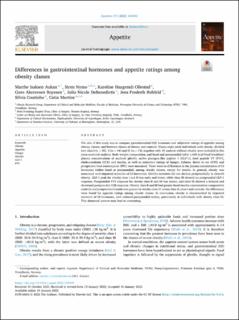Differences in gastrointestinal hormones and appetite ratings among obesity classes: Gastrointestinal hormones and appetite in obesity
| dc.contributor.author | Aukan, Marthe Isaksen | |
| dc.contributor.author | Nymo, Siren | |
| dc.contributor.author | Ollestad, Karoline Haagensli | |
| dc.contributor.author | Akersveen Boyesen, Guro | |
| dc.contributor.author | DeBenedictis, Julia Nicole | |
| dc.contributor.author | Rehfeld, Jens Frederik | |
| dc.contributor.author | Coutinho, Silvia | |
| dc.contributor.author | Martins, Catia | |
| dc.date.accessioned | 2023-01-12T14:49:37Z | |
| dc.date.available | 2023-01-12T14:49:37Z | |
| dc.date.created | 2022-04-22T13:07:25Z | |
| dc.date.issued | 2022 | |
| dc.identifier.citation | Appetite. 2022, 171 . | en_US |
| dc.identifier.issn | 0195-6663 | |
| dc.identifier.uri | https://hdl.handle.net/11250/3043155 | |
| dc.description.abstract | The aim of this study was to compare gastrointestinal (GI) hormones and subjective ratings of appetite among obesity classes, and between classes of obesity and controls. Ninety-eight adult individuals with obesity, divided into class I (n = 35), II (n = 44) and III (n = 19), together with 45 controls without obesity were included in this cross-sectional analysis. Body weight/composition, and basal and postprandial (after a 600 kcal fixed breakfast) plasma concentrations of acylated ghrelin, active glucagon-like peptide 1 (GLP-1), total peptide YY (PYY), cholecystokinin (CCK) and insulin, as well as subjective ratings of hunger, fullness, desire to eat (DTE) and prospective food consumption (PFC) were measured. There were no differences in the plasma concentration of GI hormones (either basal or postprandial) among obesity classes, except for insulin. In general, obesity was associated with impaired secretion of GI hormones. Ghrelin secretion did not decline postprandially in class-III obesity. GLP-1 peak for obesity class I and II was early and lower, while class III showed no postprandial GLP-1 response. Postprandial PYY response for obesity class II and III was absent, and class III showed a delayed and shortened postprandial CCK response. Obesity class II and III had greater basal insulin concentration compared to controls and postprandial insulin was greater in obesity class III versus class II, class I and controls. No differences were found for appetite ratings among obesity classes. In conclusion, obesity is characterized by impaired secretion of GI hormones, with reduced postprandial satiety, particularly in individuals with obesity class III. This abnormal pattern may lead to overeating. | en_US |
| dc.language.iso | eng | en_US |
| dc.publisher | Elsevier | en_US |
| dc.rights | Navngivelse 4.0 Internasjonal | * |
| dc.rights.uri | http://creativecommons.org/licenses/by/4.0/deed.no | * |
| dc.title | Differences in gastrointestinal hormones and appetite ratings among obesity classes: Gastrointestinal hormones and appetite in obesity | en_US |
| dc.title.alternative | Differences in gastrointestinal hormones and appetite ratings among obesity classes: Gastrointestinal hormones and appetite in obesity | en_US |
| dc.type | Peer reviewed | en_US |
| dc.type | Journal article | en_US |
| dc.description.version | publishedVersion | en_US |
| dc.source.pagenumber | 0 | en_US |
| dc.source.volume | 171 | en_US |
| dc.source.journal | Appetite | en_US |
| dc.identifier.doi | 10.1016/j.appet.2022.105940 | |
| dc.identifier.cristin | 2018415 | |
| cristin.ispublished | true | |
| cristin.fulltext | original | |
| cristin.qualitycode | 1 |
Tilhørende fil(er)
Denne innførselen finnes i følgende samling(er)
-
Institutt for klinisk og molekylær medisin [3428]
-
Publikasjoner fra CRIStin - NTNU [37273]
-
St. Olavs hospital [2442]

